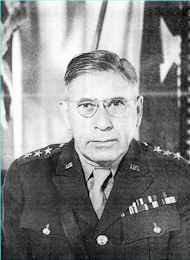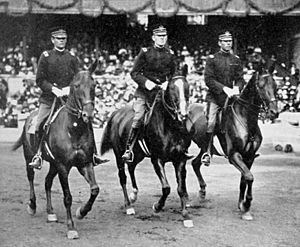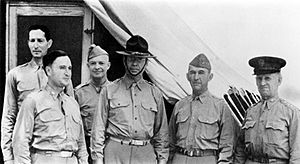Ben Lear facts for kids
Quick facts for kids
Benjamin Lear
|
|
|---|---|

General Ben Lear
|
|
| Nickname(s) | "Yoo Hoo" |
| Born | May 12, 1879 Hamilton, Ontario, Canada |
| Died | November 1, 1966 (aged 87) Murfreesboro, Tennessee, United States |
| Place of burial |
Arlington National Cemetery, Virginia, United States
|
| Allegiance | |
| Service/ |
|
| Years of service | 1898–1945 |
| Rank | |
| Service number | 0-1179 |
| Commands held | 1st Cavalry Division (1936–1938) Pacific Sector Panama Canal Zone (1938–1940) U.S. Second Army (1940–1943) Army Ground Forces (1944–1945) |
| Battles/wars | World War I World War II |
| Awards | Army Distinguished Service Medal (2) Silver Star |
| Medal record | ||
|---|---|---|
| Men's Equestrian | ||
| Representing the |
||
| Olympic Games | ||
| Bronze | 1912 Stockholm | Team eventing |
Benjamin Lear (born May 12, 1879 – died November 1, 1966) was an important United States Army general. He served in several major conflicts, including the Spanish–American War, the Philippine–American War, World War I, and World War II. Interestingly, he was also an Olympic athlete!
Contents
Early Military Life
Ben Lear was born in Hamilton, Ontario, Canada, on May 12, 1879. His journey in the military began in 1898. He joined the 1st Colorado Infantry as a first sergeant during the Spanish–American War.
He was promoted to second lieutenant during the Philippine–American War. After this war, he joined the regular army as a sergeant. Later, he also served in World War I.

In 1912, Ben Lear was part of the U.S. Olympic equestrian team. They won a bronze medal in the three-day team event at the 1912 Summer Olympics. This shows he was not only a soldier but also a talented athlete.
Lear continued his education in the army. He graduated from several important military schools. These included the Army School of the Line in 1922, the Army General Staff School in 1923, and the Army War College in 1926. These schools helped him learn how to be a great leader.
He was promoted to brigadier general in May 1936. Then, he became a major general in October 1938. He led the 1st Cavalry Division from 1936 to 1938. He also commanded the Pacific Sector of the Panama Canal Zone from 1938 to 1940.
World War II Service
Leading Training Efforts

In October 1940, Lear was promoted to lieutenant general. He became the commanding general of the U.S. Second Army from October 1940 to April 1943. In this role, he was in charge of training a huge number of U.S. soldiers for World War II. He was known for being very strict and expecting high standards from his troops.
During the Louisiana Maneuvers, which were large training exercises, Lear led his Second Army against the U.S. Third Army. He made sure his soldiers were well-trained and ready for battle.
Lear continued to lead the Second Army until April 1943.
Later Roles and Retirement
In May 1943, Lear officially retired because he reached the age limit for military service. However, he was immediately called back to duty! He served on a special board for the United States Secretary of War. He kept his rank as a lieutenant general.
On July 14, 1944, he became the Commanding General of Army Ground Forces. This was a very important job, as he was in charge of all ground troops.
In January 1945, during a difficult time in the war, he was made deputy commander of the U.S. Army in Europe. He was responsible for making sure there were enough soldiers where they were needed. He worked to improve how new soldiers were sent to replace those on the front lines. The war in Germany ended before all his changes could be fully seen.
Final Years
General Lear fully retired from the army in July 1945. On July 19, 1954, he was promoted to general by a special law passed by Congress. After retiring, he lived in Memphis, Tennessee.
He passed away on November 1, 1966, at a hospital in Murfreesboro, Tennessee. He was buried with honors at Arlington National Cemetery in Virginia.
Awards and Medals
General Lear received many awards and medals for his long and brave service. Here are some of them:
- Army Distinguished Service Medal (with an extra award)
- Silver Star
- Spanish War Service Medal
- Philippine Campaign Medal
- Army of Cuban Occupation Medal
- Army of Cuban Pacification Medal
- Mexican Border Service Medal
- World War I Victory Medal
- American Defense Service Medal
- American Campaign Medal
- European-African-Middle Eastern Campaign Medal (with three service stars)
- World War II Victory Medal
- Army of Occupation Medal
- Legion of Honour, Commandeur (from France)
Promotions Through the Ranks
General Lear started his military career as a sergeant and rose through many ranks. Here's how he was promoted over the years:
| No pin insignia in 1898 | First sergeant, Volunteer Army: May 1, 1898 |
| No pin insignia in 1899 | Second lieutenant, Volunteer Army: April 1, 1899 |
| First lieutenant, Volunteer Army: July 12, 1899 | |
| No pin insignia in 1901 | Second lieutenant, United States Army: June 12, 1901 |
| First lieutenant, United States Army: December 9, 1901 | |
| Captain, United States Army: August 10, 1912 | |
| Major, National Army: August 5, 1917 | |
| Lieutenant colonel, National Army: January 26, 1918 | |
| Colonel, temporary: August 31, 1918 | |
| Captain, Regular Army: September 25, 1919 | |
| Lieutenant colonel, Regular Army: July 1, 1920 | |
| Colonel, Regular Army: September 19, 1929 | |
| Brigadier general, Regular Army: May 1, 1936 | |
| Major general, Regular Army: October 1, 1938 | |
| Lieutenant general, Regular Army: October 1, 1940 | |
| Lieutenant general, Retired List: July 31, 1945 | |
| General, Retired List: July 19, 1954 |
Images for kids
See also
 In Spanish: Benjamin Lear para niños
In Spanish: Benjamin Lear para niños




